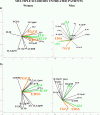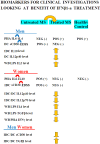A gender-related action of IFNbeta-therapy was found in multiple sclerosis
- PMID: 23148845
- PMCID: PMC3566915
- DOI: 10.1186/1479-5876-10-223
A gender-related action of IFNbeta-therapy was found in multiple sclerosis
Abstract
Background: Understanding how sexual dimorphism affects the physiological and pathological responses of the immune system is of considerable clinical importance and could lead to new approaches in therapy. Sexual dimorphism has already been noted as an important factor in autoimmune diseases: the aim of this study was to establish whether sexual dimorphism in autoimmune diseases is the result of differing pathways being involved in the regulation of T-helper (Th) cell network homeostasis.
Methods: We focused on sexually dimorphic changes in the immune response in multiple sclerosis (MS) patients in order to ascertain how these alterations relate to the pathway regulation of the cytokine homeostasis and the Th cell networks. We studied antigen presenting cell (APC)-dependent T cell activation in groups of healthy subjects, in patients under interferon (IFN) β-therapy and untreated. Cytokines, soluble (s) CD30 and the expanded disability status scale (EDSS) were used as biomarkers for T cell differentiation and neurological deficit.
Results: The data confirm our belief that sexual dimorphism in autoimmune diseases is the result of differing pathways that regulate Th cell network homeostasis: interleukin (IL) 6 pathways in women and IFNγ pathways in men. Given the increased susceptibility of women to MS and the significance of IL6 in the autoimmune process compared to IFNγ, it is logical to assume that IL6 pathways are in some way implicated in the prevalence of autoimmune diseases in women. Indeed, our data indicate that IL6 pathways are also involved in T regulatory (Treg) cell imbalance and an increase in neurological deficit in both men and women groups of MS patients, underlining the autoimmune etiology of multiple sclerosis. In further support of differing cytokine pathways in men and women, we noted that the efficacy of IFNβ-treatment in the re-establishment of Th-network balance and in the delaying of the neurological disability progression is linked to the IL6 pathway in women, but to the IFNγ pathway in men. Lastly, we also identified specific gender biomarkers for the use in therapy.
Conclusions: The identification of gender-specific drugs is of considerable importance in translational medicine and will undoubtedly lead to more appropriate therapeutic strategies and more successful treatment.
Figures








Similar articles
-
Immunological study of IFNbeta-1a-treated and untreated multiple sclerosis patients: clarifying IFNbeta mechanisms and establishing specific dendritic cell immunotherapy.Neuroimmunomodulation. 2005;12(1):29-44. doi: 10.1159/000082362. Neuroimmunomodulation. 2005. PMID: 15756051 Clinical Trial.
-
CD30 antigen and multiple sclerosis: CD30, an important costimulatory molecule and marker of a regulatory subpopulation of dendritic cells, is involved in the maintenance of the physiological balance between TH1/TH2 immune responses and tolerance. The role of IFNbeta-1a in the treatment of multiple sclerosis.Neuroimmunomodulation. 2005;12(4):220-34. doi: 10.1159/000085654. Neuroimmunomodulation. 2005. PMID: 15990453
-
Soluble CD30: a biomarker for evaluating the clinical risk versus benefit of IFNbeta1A treatment in multiple sclerosis patients.Int J Immunopathol Pharmacol. 2010 Jan-Mar;23(1):213-26. doi: 10.1177/039463201002300119. Int J Immunopathol Pharmacol. 2010. PMID: 20378007
-
T Helper Cells: The Modulators of Inflammation in Multiple Sclerosis.Cells. 2020 Feb 19;9(2):482. doi: 10.3390/cells9020482. Cells. 2020. PMID: 32093011 Free PMC article. Review.
-
Interferon-beta inhibits Th17 cell differentiation in patients with multiple sclerosis.Endocr Metab Immune Disord Drug Targets. 2010 Jun;10(2):161-7. doi: 10.2174/187153010791213029. Endocr Metab Immune Disord Drug Targets. 2010. PMID: 20384573 Review.
Cited by
-
Mitochondrial maintenance failure in aging and role of sexual dimorphism.Arch Biochem Biophys. 2015 Jun 15;576:17-31. doi: 10.1016/j.abb.2014.10.008. Epub 2014 Oct 25. Arch Biochem Biophys. 2015. PMID: 25447815 Free PMC article. Review.
-
Lower serum levels of Th2-related chemokine CCL22 in women patients with multiple sclerosis: a comparison between patients and healthy women.Inflammation. 2014 Apr;37(2):604-10. doi: 10.1007/s10753-013-9775-z. Inflammation. 2014. PMID: 24254331
-
Ageing gender-specific "Biomarkers of Homeostasis", to protect ourselves against the diseases of the old age.Immun Ageing. 2014 Feb 6;11(1):3. doi: 10.1186/1742-4933-11-3. Immun Ageing. 2014. PMID: 24498974 Free PMC article.
-
Multiple Sclerosis and Cancer: The Ying-Yang Effect of Disease Modifying Therapies.Front Immunol. 2020 Jan 10;10:2954. doi: 10.3389/fimmu.2019.02954. eCollection 2019. Front Immunol. 2020. PMID: 31998289 Free PMC article. Review.
-
CCR5 Δ32 and CTLA-4 +49 A/G Gene Polymorphisms and Interferon-β Treatment Response in Croatian and Slovenian Multiple Sclerosis Patients.Int J Mol Sci. 2024 Jul 5;25(13):7412. doi: 10.3390/ijms25137412. Int J Mol Sci. 2024. PMID: 39000519 Free PMC article.
References
-
- Yakoo T, Takakuwa K, Ooki I, Kikuchi A, Tamura M, Tanaka K. Alterations of TH1 and TH2 cells by intracellular cytokine detection in patients with unexplained recurrent abortion before and after immunotherapy with the husband’s mononuclear cells. Fertil Steril. 2006;85:1452–1458. doi: 10.1016/j.fertnstert.2005.10.058. - DOI - PubMed
MeSH terms
Substances
LinkOut - more resources
Full Text Sources
Medical

